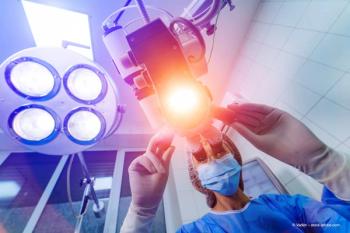
Technology heralds retinal prosthesis, advanced lasers
Year unfolds availability of innovative devices; ushers new era of patient care
Take-home
The advent of a retinal prosthesis system coupled with the latest generation of laser technology brings a new era of patient care in 2013.
Dr. Dugel
By Lynda Charters; Reviewed by Pravin U. Dugel, MD, and Paul Hahn, MD, PhD
The approval of retinal prosthesis system introduction of lasers that can selective treat structures in the retina were among the technologic highlights of 2013.
The Argus II Retinal Prosthesis System (Second Sight Medical Products)-colloquially referred to as the “bionic eye”-was approved by the FDA as a humanitarian use device in February 2013, after more than 20 years of research and development pioneered by Mark Humayun, MD, PhD, professor of ophthalmology, Biomedical Engineering, and Cell Neurobiology at the University of Southern California.
This implant, which is surgically implanted in the eye, communicates wirelessly to an external camera, thereby providing artificial visual stimuli to improve vision that was once considered to be permanently lost in patients with retinal diseases, specifically retinitis pigmentosa, said Paul Hahn, MD, PhD, assistant professor of Ophthalmology, Duke University School of Medicine, Durham, NC.
“From a medical standpoint, the availability of this technology is revolutionary and heralds a new era of patient care in which rather than just slowing or stabilizing vision loss, we can restore vision that was once considered to be lost permanently,” Dr. Hahn said.
Though the technology is approved, the device is not yet commercially available. It has not yet been implanted on an FDA-approved basis yet, but this should happen in the very near future, he explained.
“The other big event along with approval of the [device] is that Medicare has agreed to fund its implantation,” Dr. Hahn said. “The lack of insurance coverage had been expected to be a big barrier to use of the device.”
Implantation of the device currently is approved only for patients with retinitis pigmentosa with visual acuity of bare light perception or worse.
“These are profoundly blind patients,” he said.
Investigations with the device for other blinding diseases are currently under way.
Benefits to patients
The effect of the implantation can be substantial for some patients. Before implantation, these patients barely know if the brightest of lights are on or off, Dr. Hahn explained.
“After implantation, they may feel more socially connected through visual cues that allow them to function better in everyday living,” he said. “For example, the patients can often identify straight lines in a crosswalk or identify a doorway, which helps them be more independent.”
In simulated tests, some patients with the implant can read large letters on a computer screen, which he described as a profound improvement.
One patient who attended a music concert reported that she was able to see a reflection of the sequins on the performer’s dress. Other patients have reported seeing fireworks. Dr. Hahn believes that they are seeing flashes of light that correspond to the location of the fireworks.
“The patients do not yet have true restoration of vision,” he said. “They cannot read or see faces, but they get visual cues that may help them feel more connected.”
Dr. Hahn
Advanced laser technology
Pravin U. Dugel, MD, considers the latest generation of lasers to be noteworthy. He anticipates that laser photocoagulation will be reintroduced to treat retinal diseases. There will be a paradigm shift from traditional laser photocoagulation.
“The newer lasers are much more selective and can specifically target the retinal pigment epithelial (RPE) cells,” said Dr. Dugel, clinical associate professor of ophthalmology, Keck School of Medicine, University of Southern California, Los Angeles.
The Topcon and Endpoint Management lasers will be beneficial, because rather than destroying all retinal tissue, they have the potential to target RPE cells selectively, he said.
“We will, I believe, be talking about laser photostimulation, rather than laser photocoagulation,” he said.
Pravin U. Dugel, MD
Dr. Dugel is a consultant to Topcon.
E: pdugel@gmail.com
Paul Hahn, MD, PhD
Dr. Hahn has no financial interest in the subject matter.
E: paul.s.hahn@duke.edu
Newsletter
Keep your retina practice on the forefront—subscribe for expert analysis and emerging trends in retinal disease management.











































